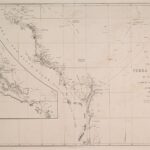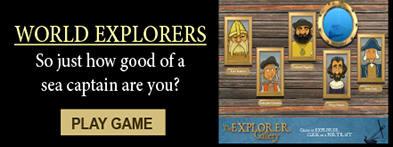Matthew Flinders
Explorer
Modern
Quick Facts:
He was a leading maritime explorer of Australia. He named the continent and produced the most accurate early atlas of the geography
Introduction
Matthew Flinders, the first person to circumnavigate (sail around) Australia, also gave the country its name. There are monuments to him throughout several Australian cities, as well as to his cat, Trim – the first feline to circumnavigate the continent.1
Biography
Early Life
The oldest of seven children, Matthew Flinders was born March 16, 1774 at Donington, Lincolnshire, England. He received a good education because it was thought he would become a surgeon like his father and grandfather. However, after reading the book Robinson Crusoe, Flinders developed a passion for seafaring.2 His first opportunity for adventure came in 1791 when he joined the crew of HMS Providence on a voyage to modern day Tahiti where they stayed for three months. While aboard the ship, he gained knowledge of navigation, tracking star patterns, using tools like the compass, and he took lessons from Bligh on chart construction.3
It was his journey on the Reliance, however, that would give Flinders a chance to make history. In 1794, under the sail of Captain Henry Waterhouse, the Reliance embarked to Terra Australis Incognita, Latin for “the unknown southern land” – the earliest name for what we now call Australia. At one time, this land was referred to as New Holland, first applied by Dutch seafarer Abel Tasman.4 And while there were small territories under British control, much of the region was still unexplored. After arriving on the continent, expeditions were taken to survey coastal areas in search of harbors, rivers, and safe anchorages for ships. They also went into inland regions along rivers and across the mountains. They explored areas like the New South Wales coast, Port Jackson, and Botany Bay, and went inland on the George’s River on the small boat Tom Thumb.5
Voyages
Principal Voyage
Flinders mapped much of the geography during these trips between October 1798 and January 1799. With his friend George Bass, they successfully became the first sailors to sail all the way around Van Diem’s Land (modern day Tasmania) in 1798 aboard the Norfolk. They proved that Van Diem’s Land was not part of the mainland, but was its own island. In March 1800, Flinders and the Reliance set sail to return to England. They arrived back in Plymouth on August 27, 1800. Flinders had been away from home for five and a half years, but his journey to Terra Australis Incognita was just beginning.
After only being home eleven days, Flinders gained information on a plan to further explore Terra Australis. He wrote a letter requesting support for a voyage to perform a circumnavigation of Australia.6 He was chosen as commander, and began his journey in January 1801 aboard his ship, the Investigator. He reached Terra Australis in December and started surveying and charting the continent. During his journey, he explored several places including Spencer’s Gulf, Kangaroo Island, Timor, Java, and Port Jackson – present day Sydney. He arrived back in Sydney in 1803, becoming the first man to circle the entire Australian continent.
Subsequent Voyages
Unfortunately, the Investigator’s wood began to rot beyond repair, so Flinders decided to return back to England only two years into his expedition. His new ship Porpoise ran aground on a reef off the coast of Queensland. He got a new ship called the Cumberland. When his ship began to leak, he was forced to dock in Ile de France [Mauritius]. By this time, war had broken out between France and England, and Flinders, being thought a spy, was detained for 6 years. During his imprisonment, he worked on his papers and charts. He was released in 1810, and allowed to return to England.
Later Years and Death
Matthew Flinders returned to England on October 23, 1810. He was received with honours and a promotion to post-captain. Sadly, his health had began to fail due to his time in captivity. He spent the next four years writing down his findings, and ultimately completed his great work A Voyage to Terra Australis. He died on July 19, 1814, the day after his book was published. In his popular book Flinders was the first to use the name ‘Australia’ consistently, and as a result the name was gradually adopted.
Legacy
Leader of the first circumnavigation of Australia, Matthew Flinders mapped an entire continent and gave it its name. His passion for the sea lead him to a life dedicated to discovery. His journals, maps, atlas and countless drawings were essential documents that contributed to the development of Australia. He is honored throughout Australian states with statues praising his accomplishment of, literally, putting Australia on the map.
Endnotes
- Tim Flannery, Introduction to Terra Australis: Text Classics, Matthew Flinders’ Great Adventures in the Circumnavigation of Australia, by Matthew Flinders (Melbourne: Text Publishing, 2000), vii.
- Kenneth Morgan, Matthew Flinders, Maritime Explorer of Australia (New York: Bloomsbury Publishing, 2016), 5.
- Morgan, Matthew Flinders, 11.
- Ab Hoving and Cor Emke, The Ships of Abel Tasman (The Netherlands: Uitgeverij Verloren, 2000), 23.
- Morgan, Matthew Flinders, 23.
- Morgan, Matthew Flinders, 46 – 47.
Bibliography
Flannery, Tim. Introduction to Terra Australis: Text Classics, Matthew Flinders’ Great Adventures in the Circumnavigation of Australia, by Matthew Flinders, vii. Melbourne: Text Publishing, 2000.
Hoving, Ab and Cor Emke. The Ships of Abel Tasman. The Netherlands: Uitgeverij Verloren, 2000.
Morgan, Kenneth Matthew Flinders, Maritime Explorer of Australia. New York: Bloomsbury Publishing, 2016.
Gallery
- Bronze statue showing Matthew absorbed in his work charting the coastline of Australia, with his feline Trim by his side (Credit: Flinders Memorial)
- HMS Investigator, 1st ship to circumnavigate Australia (Credit: Flinders Memorial)
- General chart of Terra Australis or Australia showing the parts explored between 1798 and 1803 by M. Flinders Commr. of H.M.S. Investigator. (Credit: National Library of Australia)






